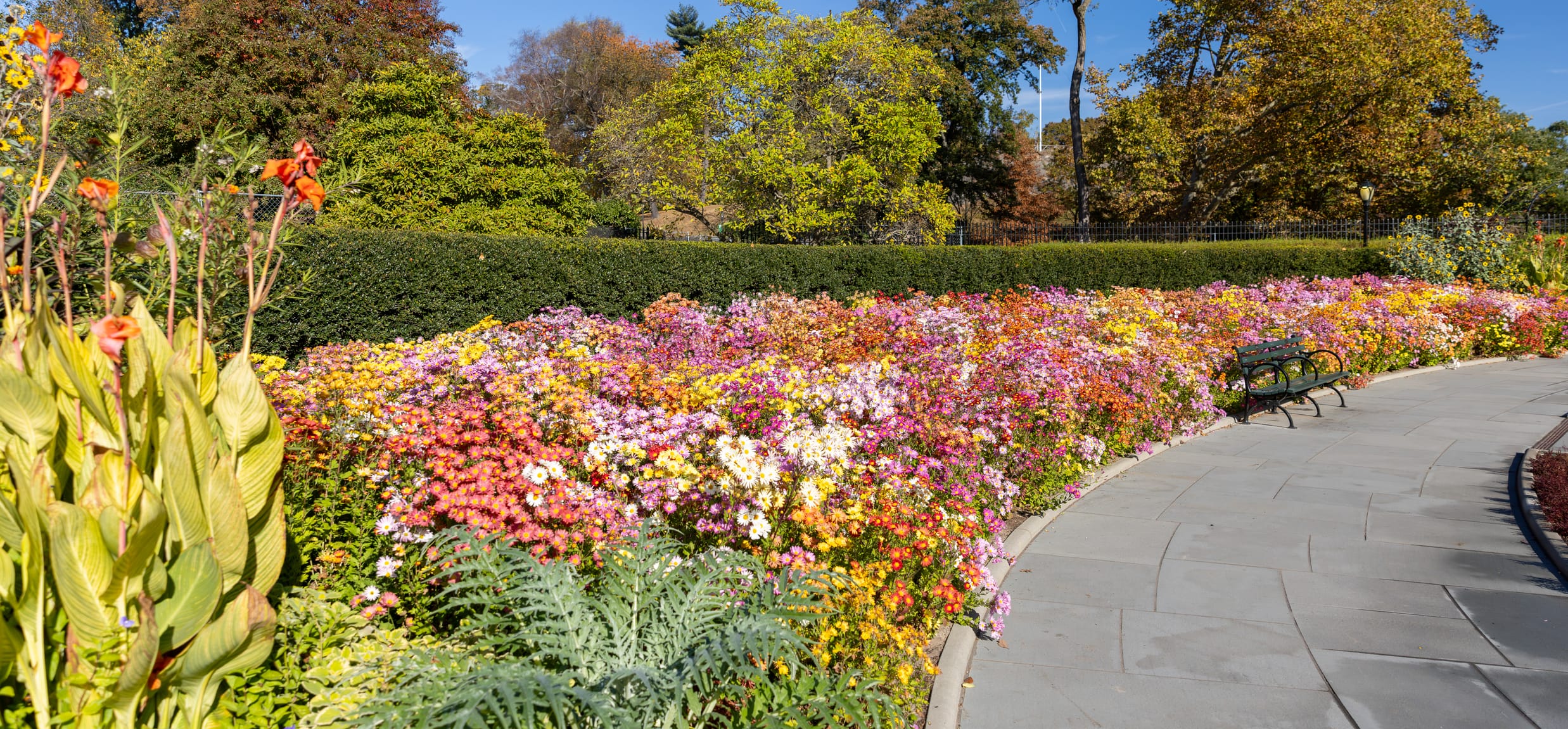Restoration
Restoration of the Conservatory Garden

Our restoration of the Conservatory Garden focused on its hardscapes, architectural features, and utilities—almost all original to the Garden’s 1937 construction.
Originally conceived by Central Park designers Frederick Law Olmsted and Calvert Vaux as an arboretum, the site of the Conservatory Garden was initially a nursery for growing plants for the Park. By the late 1880s, greenhouses were built on site, followed shortly by an ornate glass conservatory (the origin of the Conservatory Garden’s name). After falling into disrepair, the conservatory was demolished in the early 1930s and the six-acre formal outdoor garden that we now know was conceived and built in 1937.
Located off Fifth Avenue between East 104th and 106th Streets, the Garden is made up of three spaces: the French Garden, the Italian Garden, and the English Garden. Known for its horticultural excellence, the Garden’s ornamental plantings are expertly maintained year-round. Conservancy staff curates annual displays throughout the Garden, which opens and closes daily to the public.
The last significant restoration of the Conservatory Garden was in 1983, which focused primarily on restoring its horticultural elements. The Central Park Conservancy’s most recent restoration proceeded in several phases—including a comprehensive reconstruction of all Garden pavements, site furnishings, fountains, and infrastructure systems, as well as the pergola and the crabapple allées—to improve accessibility, ensure the long-term preservation of the Garden, and provide the best quality experience for visitors.

The Garden in 1937
English Garden
Construction on the English Garden began in winter 2022 and was completed in winter 2023. This phase of work included:
- Restoring the distinctive bluestone pavers
- Replacing the utility infrastructure systems and improving drainage
- Modernizing of the fountain system
- Restoring benches, replacing and realigning retaining walls and stairs, and refurbishing unique architectural and decorative features
- Ensuring all aspects of the Garden meet current code requirements

Completed work at the English Garden.
(Photo Credit: ©Barrett Doherty)
Conservatory Garden Infrastructure
In order to address larger stormwater drainage issues, the Conservancy completed a critical infrastructure project in spring 2023. Key components of this phase included:
- Installing a new enlarged storm drainage line under the pavement
- Modifying grading to improve water runoff

Drainage line installation
French Garden
The French Garden phase started in spring 2023 and was completed in spring 2024. With the addition of accessibility improvements, the scope of work was similar to work completed at the English Garden and included:
- Increasing accessibility by eliminating stairs and installing ramps
- Restoring the distinctive bluestone pavers
- Replacing the utility infrastructure systems and improving drainage
- Modernizing the fountain system
- Restoring benches, replacing and realigning retaining walls, and refurbishing unique architectural and decorative features
- Ensuring all aspects of the Garden meet current code requirements



Completed work at French Garden
(Photo credit: ©Barrett Doherty)
Italian Garden
The final phase of construction is in the Italian Garden, which was completed in spring 2025. This phase focused on these elements:
Crabapple Allées
In the fall of 2023, the Conservancy replaced the rows of crabapple trees along the paths in the Italian Garden. Flowering crabapples have a much shorter lifespan than most of the large canopy trees found throughout the Park. The trees were planted in the mid-1950s to replace the original trees from 1937. They were over 70 years old at the time of their removal in October 2023 and showed significant signs of decay and decline.
Recognizing the onset of the crabapples’ decline the Central Park Conservancy’s team of landscape architects, horticulturalists, arborists, and other experts planned for their replacement. We identified a crabapple cultivar that fit all the aesthetic qualities of the historic allées and is more disease resistant. In addition to the tree replacement at the allées, the Conservancy also replaced the bluestone pavers, benches, post and chain fencing, and upgraded the electrical system.
To learn more about the history of the Garden’s crabapples and the Conservancy’s extensive efforts to research, select, and grow the replacement trees, visit our magazine.
Pergola
The steel pergola at the west side of the Italian Garden, which has severely deteriorated, was restored. Scope of work for the pergola included:
- Pruning of the wisteria and removing vines intertwined in the pergola structure; healthy plants were preserved
- Cleaning and repairing the pergola column bases
- Replacing the cast stone coping at the retaining walls
- Repointing the brick and stone veneer walls
- Cleaning, removing rust, refinishing, and repainting the entire steel pergola structure

Repaired and repainted pergola
General Site Work
The remaining work in the Italian Garden started on May 13, 2024 and was completed in spring 2025. The team replaced pavements, upgraded the central fountain’s infrastructure systems, and reconstructed the Vanderbilt steps. This work required:
- Reconstructing hardscape elements, including replacement of bluestone pavements in their historic pattern; in-kind replacement of concrete pavement; reconstructing existing concrete curbs; repairing and restoring existing walls, stairs, and copings
- Replacing, refurbishing, and restoring site furnishings, including benches, sections of fencing, and handrails
- Replacing fountain infrastructure, waterproofing fountain basin, and replacing fountain controls
- Upgrading drainage infrastructure to capture water runoff from adjacent landscapes